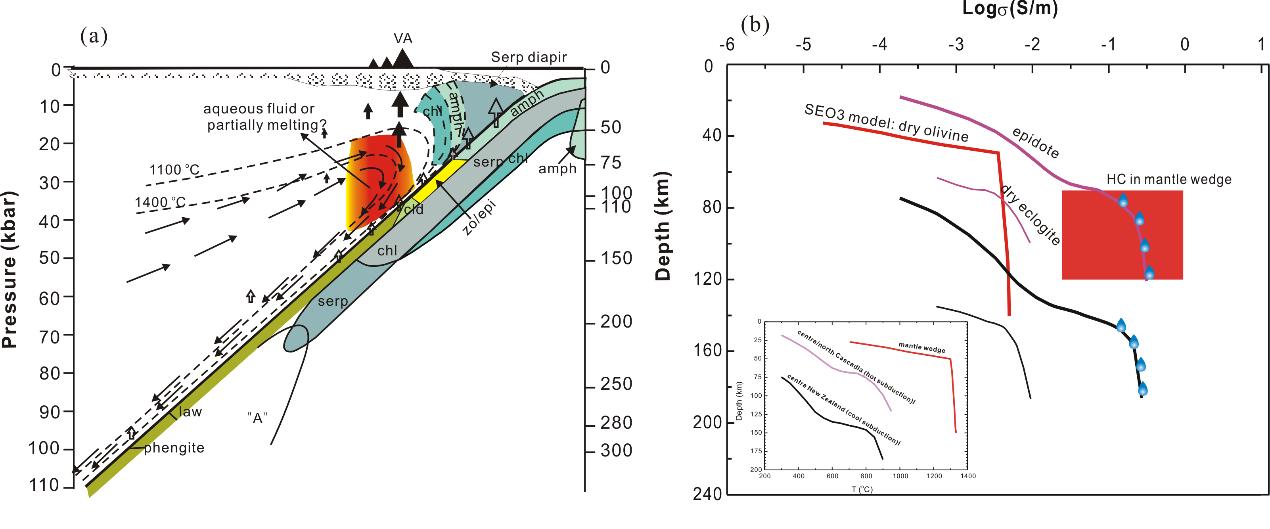Electromagnetic and seismic results from various subduction zones reveal the presence of anomalies of electrical conductivity and seismic wave attenuation in the mantle wedge and fore-arc regions, characterized by electrical conductivity up to 1 S/m. For the young and hot subduction zones with high thermal gradient, partial melting in the mantle wedge is extensively considered to be the cause of anomalously high conductivity. However, based on the petrological studies, epidote/zoisite reaches 30-35 vol % in abundance occurring in epidote-blueschist facies in the subduction slab, and it with huge stability field could contribute to fluid flux to the mantle wedge at depths of 100-120 km. Therefore, epidote is very likely to make critical contribution to the high-conductivity anomalies in deep mantle wedge. Nevertheless, no previous study has been devoted to the electrical conductivity of epidote under the conditions prevailing in subduction zones and its possible contribution to the anomalously high conductivity regions in the deep mantle wedge.
Dr. HU Haiying firstly measured the electrical property of epidote at conditions of 0.5-1.5 GPa and 573-1273 K on the AC impedance spectroscopy experiment platform established by Prof. DAI Lidong’s group at Institute of Geochemistry, Chinese Academy of Sciences (IGCAS).
The results indicate that the pressure dependence on the electrical conductivity of epidote is relatively weak compared to temperature, and the remarkable dehydration reaction of epidote happens around 1073 K through the observation of the abrupt variation of electrical conductivity. The discontinuous variation of electrical conductivity in high temperature regimes can be ascribed to the presence of aqueous fluid in sample and the simultaneous escape of fluids from sample cell. The existence of free fluid was verified by the optical microscope and scanning electron microscope images on the recovered sample after measurement.
Moreover, taking into account the petrological and geothermal structures of subduction zones, the aqueous fluid produced by epidote dehydration could be responsible for the anomalously high conductivity in deep mantle wedges observed at depths of 70-120 km, particularly in hot subduction zones setting such as central Cascadia and central New Zealand. The study offers another new insight into the cause of high-conductivity anomalies in the subduction zone.
This work has been published in the top journal of Nature Index as follows,
Haiying Hu, Lidong Dai*, Heping Li, Keshi Hui, Wenqing Sun. Influence of dehydration on the electrical conductivity of epidote and implications for high-conductivity anomalies in subduction zones. Journal of Geophysical Research: Solid Earth, 2017, 122, 2751-2762, doi: 10.1002/2016JB013767.
|

|
| Fig. (a) Mineralogical model of the subduction zone is referred from Schmidt and Poli [1998]. The red regions in the mantle wedge is the anomalous high conductivity zones extensively detected by magnetotelluric and seismic velocity surveys; (b) Conductivity-depth profiles established from the data of epidote in this study, dry eclogite from Dai et al. [2016] and SEO3 model for dry olivine from Constable [2006] based on the thermal structure of subduction slab in the typical hot (Central Cascadia subduction zones) and cool (central New Zealand subduction zone) subduction zones [Syracuse et al., 2010], and the mantle wedge [Currie et al., 2004], respectively, which are shown in the inset. The thick solid purple black lines represent EC profile from the present data before epidote dehydration in hot and cool subduction slab, respectively. The thin solid purple and black lines denote EC profile from the data of dry eclogite in hot and cool subduction slab, respectively. The solid red line indicates the SEO3 model for dry olivine in the mantle wedge. The red rectangle shows the HCZ in the mantle wedge at depths of ~70?120 km. The waterdrops refer to the epidote dehydration process. Abbreviations: ‘A’, phase A; amph, amphibole; chl, chlorite; cld, chloritoid; serp, serpentine, law, lawsonite; zo, zoisite, epi, epidote. (Image by IGCAS) |
Contact:
DAI Lidong
Institute of Geochemistry, Chinese Academy of Sciences
E-mail: dailidong@vip.gyig.ac.cn
(By Prof. DAI Lidong’s group)